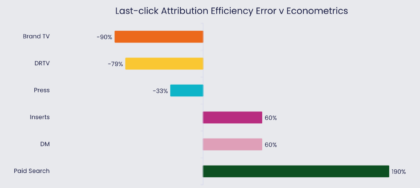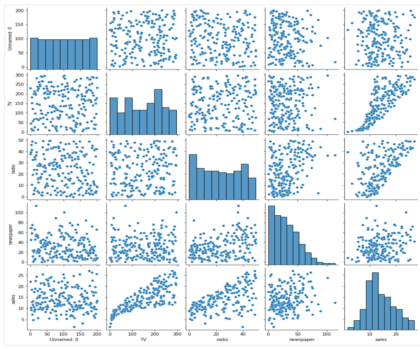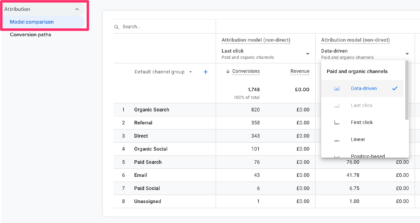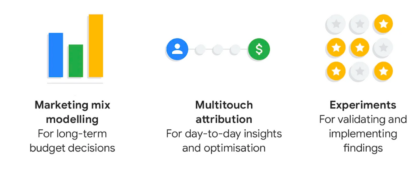In today’s complex digital ecosystem, no single measurement tool can capture every user interaction with your brand online – from seeing an ad to making a purchase. (If it can, please tell us and we’ll delete this article immediately!)
Every ad network and tool gives different information and has its own way of attributing value. So, which data source should you trust?
64% of marketers admit they’re overwhelmed by the number of data, measurement, and analytics solutions that are available and report decreased confidence in those solutions’ ability to produce solid business results.
Add to this the fact that many marketers are being tasked with doing more for less, there’s now an urgency to justify the incremental value of marketing to the CFO.
The death limitations of digital attribution
We’re entering a new privacy-first era of marketing measurement. While third party cookies are currently in circulation, the official deadline for phasing them out is in 2024.
There’s a misconception that if the cookie dies, so does attribution. However, there are a couple of reasons why attribution may have a longer shelf life than expected.
Multiple solutions have been developed for digital attribution which are no longer reliant on third party cookies. Google Analytics 4 now incorporates data modelling to fill in the gaps due to privacy limitations. Other methods include using data clean room technology (such as Google’s Ads Data Hub), which provides access to user-level data in a way that’s privacy-compliant. Not forgetting universal Iidentity solutions, such as the Universal ID project, designed to provide shared identifiers for tracing users throughout the chain of supply without syncing cookies.
However, the problem with digital attribution is that the models give too much credit to the short-term, direct effects of marketing, and overcredit tactics such as paid search and shopping ads.
 Source: Adam&Eve DDB
Source: Adam&Eve DDB
Using only digital attribution to measure performance can lead to short-termism in marketing. We therefore need to explore alternative measurement tactics to truly understand how effective different marketing channels are and what’s really having an impact on the bottom line.
Three methods of assessing value
There are three popular methods to answering the question of “What is my return on marketing investment?”:
- Marketing mix modelling (MMM)
- Multi-touch attribution modelling (MTA)
- Testing/experiments
Media mix modelling (econometrics) is the gold standard of measurement. Its strength over other methods, such as digital attribution, lies in quantifying incremental sales from marketing spend. Econometrics includes all influences throughout the journey, and can untangle incremental sales from online ads vs sales caused by other things. Multi-touch attribution (MTA) is used to apportion value to various touchpoints in a customer journey. It’s very useful for digital optimisation, but does not factor in offline interactions. MTA is available in various forms in Google Analytics, including data driven attribution, which uses machine learning and historic data to distribute credit to all ad clicks that led to a conversion.
Multi-touch attribution (MTA) is used to apportion value to various touchpoints in a customer journey. It’s very useful for digital optimisation, but does not factor in offline interactions. MTA is available in various forms in Google Analytics, including data driven attribution, which uses machine learning and historic data to distribute credit to all ad clicks that led to a conversion. Experiments are a method of A/B testing digital marketing campaigns and tactics. It involves a control group & treatment group. The control group doesn’t see the advertising, the treatment group does. This is more difficult to run, and therefore less commonplace for smaller brands. Many brands can’t afford trial reducing (or stopping) ad spend in certain areas because they contribute so much of the total revenue.
Experiments are a method of A/B testing digital marketing campaigns and tactics. It involves a control group & treatment group. The control group doesn’t see the advertising, the treatment group does. This is more difficult to run, and therefore less commonplace for smaller brands. Many brands can’t afford trial reducing (or stopping) ad spend in certain areas because they contribute so much of the total revenue. Source: Think With Google
Source: Think With Google
Don’t overlook first-party data
Digital attribution tools (e.g. platforms such as Google Analytics) won’t automatically connect the dots between online campaigns and offline interactions. Particularly in B2B, there’s a real need to connect first-party data sources, such as customer data in your CRM system, with your analytics platform to assess the true value of your activities. How else will you know what happened to a digital lead once it’s been passed to your sales team?
This is where CRM / Google Analytics integrations come in handy, as they enable you to pass the following data back in to Google Analytics:
- Actual sale value of conversions passed to CRM
- Lead score based on CRM activity
- CRM opportunities created
- Sales conversion rate
Provided you have a relatively modern CRM system, you should be able to integrate it with Google Analytics to get a view of offline interactions. More on that here.
Avoiding short-termism
In the potentially turbulent months ahead for advertisers, if you’re using digital attribution (e.g. Google Analytics) in isolation, it will be tempting to invest more in the areas that show short-term performance improvements.
It can be difficult to assess the business impact of long-term marketing investments; but by layering in econometrics (MMM) you will get a high-level view of the efficacy of all your marketing spend (online and offline).
If appropriate and affordable for your business, you can conduct incrementality experiments to gain insights that help set channel-specific budgets and confirm findings from both MMM and attribution.
Triangulate your data
Over the next few years, more marketers are expected to invest in MMM and experiments to triangulate the data provided via digital attribution platforms such as GA4, to more accurately assess marketing effectiveness.
MMM will account for offline activity, brand investments, and help your business get a read on incrementality. Digital attribution and multi-touch attribution modelling will help optimise digital specific tactics. While experiments, for those that can afford to maintain them, will give unrivalled answers on whether a set tactic will drive incremental returns.
However, the real power will come through unifying these data sources to provide insight from the big picture, down to the micro levels of performance.
Developing a unified view of performance will gain you significant strategic advantage on your marketing investments in the years to come.
If you’d like to speak to our team about reporting, contact our Data and Insights specialists.





